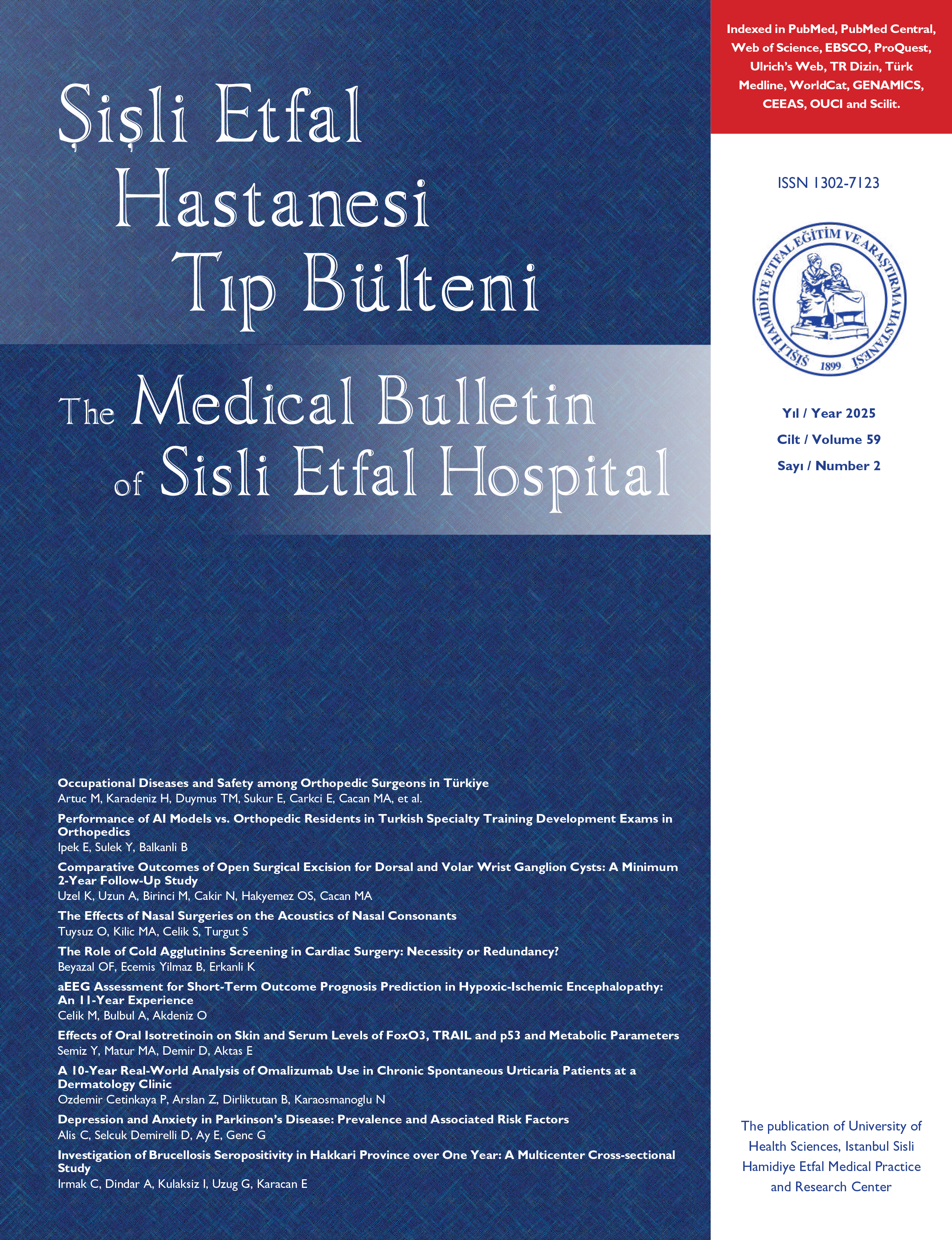
Ailesel Akdeniz ateşi tanılı hastalarda ultrasonografik femoral kartilaj kalınlığı ölçümü ve amioidoz ile diğer hastalık özellikleri ile ilişkisi
Halise Hande Gezer1, Didem Erdem Gursoy2, Sevtap Acer Kasman3, Hatice Sule Baklacioglu4, Mehmet Tuncay Duruoz51Ümraniye Eğitim ve Araştırma Hastanesi, Romatoloji Bölümü, İstanbul2İstanbul Okmeydanı Eğitim ve Araştırma Hastanesi, Romatoloji Bölümü, İstanbul
3Kartal Lütfi Kırdar Şehir Hastanesi, Romatoloji Bölümü, İstanbul
4Samsun Eğitim ve Araştırma Hastanesi, Romatoloji Bölümü, Samsun
5Marmara Üniversitesi Tıp Fakültesi, Romatoloji Anabilim Dalı, PMR Bilim Dalı, İstanbul
AMAÇ: Bu çalışmada, ailesel Akdeniz ateşi (AAA) olan hastalarda ve sağlıklı bireylerde femoral kartilaj kalınlığının (FKK) ölçülmesi ve FKK ile amiloidoz gelişimi ve klinik özellikler ile ilişkisinin değerlendirilmesi amaçlanmıştır.
METOD: Çalışmaya Tel-Hashomer kriterlerine göre AAA tanısı konan hastalar ve sağlıklı kontroller dahil edildi. Her iki dizde femoral kartilaj kalınlığı maksimum diz fleksiyonunda 7-12 MHz lineer prob ile ölçüldü. Her iki dizden üç noktadan ölçüm alındı: lateral femoral kondil (LFK), interkondiler alan (ICA) ve medial femoral kondil (MFK). Hastaların klinik özelliklerinden hastalık süresi, ilaçlar, komorbid durumlar, amiloidoz, kronik böbrek yetmezliği (KBY), FMF gen mutasyonu, artrit, sakroiliit, PRAS skoru ve Fiziksel Aktivite Anketi Kısa Form (IPAQ-SF) skoru kaydedildi.
BULGULAR: Çalışmaya 46 AAA (36 kadın) ve 20 yaş-cinsiyet-BMI uyumlu kontrol (14 kadın) dahil edildi. Hastaların ve kontrollerin yaş ortalamaları sırasıyla 37 ±12.9 ve 37.5 ±8.6 yıldı. Yedi hastada (%15.2) amiloidoz, 3 hastada (%6.5) KBY ve 8 hastada (%17) diz artriti meydana geldi. Hastalık aktivitesi %55.8'inde hafif, %20.9'unda orta ve %23.23'ünde şiddetliydi. AAA ve kontrol gruplarında milimetre cinsinden ortalama FKK değerleri şu şekildeydi: sağda LFK 1,9±0,5 ve 2±0,52, ICA 2,2±0,77 ve 2,25±0,97, MFK 2±0,47 ve 2,25±0,72; sol tarafta LFK 1,9±0,4 ve 2,05±0,55, ICA 2,25±0,87 ve 2,25±0,87, MFK 1,85±0,5 ve 2,25±0,6. AAA'li hastalarda kontrollere kıyasla her iki diz LFK (p<0.05) ve sol MFK (p<0.05) kıkırdak kalınlığı azalmıştı. Artrit, amiloidoz ve KBY olan ve olmayan hastalarda FCT ölçümleri benzerdi (p>0.05). FKK skorları hastalık aktivite grupları arasında farklı değildi (p>0.05).
SONUÇ: AAA hastalarında kontrollere kıyasla FKK azalmıştır ve FKK ile amiloidoz ve hastalık aktivitesi arasında anlamlı bir ilişki yoktur. (SETB-2021-12-369)
Anahtar Kelimeler: Ailesel akdeniz ateşi, amiloidoz, kartilaj
Ultrasound Measurement of Femoral Cartilage Thickness in Patients with Familial Mediterranean Fever and its Relation to Amyloidosis and Other Disease Characteristics
Halise Hande Gezer1, Didem Erdem Gursoy2, Sevtap Acer Kasman3, Hatice Sule Baklacioglu4, Mehmet Tuncay Duruoz51Department of Rheumatology, Ümraniye Training and Research Hospital, İstanbul, Türkiye2Department of Rheumatology, İstanbul Okmeydanı Training and Research Hospital, İstanbul, Türkiye
3Department of Rheumatology, Kartal Lütfi Kırdar City Hospital, İstanbul, Türkiye
4Department of Rheumatology, Samsun Training and Research Hospital, Samsun, Türkiye
5Department of PMR, Rheumatology Division, Marmara University Faculty of Medicine, Istanbul, Türkiye
Objectives: This study aimed to determine femoral cartilage thickness (FCT) in patients with familial Mediterranean fever (FMF) and healthy individuals and to assess the relationship of FCT with the development of amyloidosis and clinical features.
Methods: Patients diagnosed with FMF according to the Tel-Hashomer criteria and healthy controls were included in the study. FCT of both knees was measured with a 712 MHz linear probe in maximum knee flexion. Three midpoint measurements were obtained from each knee: Lateral femoral condyle (LFC), intercondylar area (ICA), and medial femoral condyle (MFC). The patients clinic characteristics include disease duration, medications, comorbid conditions, amyloidosis, chronic renal failure (CRF), FMF gene mutation, arthritis, sacroiliitis, PRAS score, and Physical Activity Questionnaire Short Form score were recorded.
Results: A total of 46 patients with FMF (36 women) and 20 age-sex-body mass index-matched controls (14 women) were enrolled in this study. The patients and controls mean age were 37±12.9 and 37.5±8.6 years, respectively. Amyloidosis occurred in 7 patients (15.2%), CRF in 3 (6.5%), and knee arthritis in 8 (17%). Disease activity was mild in 55.8%, moderate in 20.9%, and severe in 23.23% of the patients. The mean FCT in millimeter values in the FMF and control groups was as follows: On the right side, LFC 1.9±0.5 and 2±0.52, ICA 2.2±0.77 and 2.25±0.97, and MFC 2±0.47 and 2.25±0.72; on the left side, LFC 1.9±0.4 and 2.05±0.55, ICA 2.25±0.87 and 2.25±0.87, and MFC 1.85±0.5 and 2.25±0.6. Patients with FMF had decreased cartilage thickness at the lateral condyle of both knees (p<0.05) and medial condyle of the left knee (p<0.05) compared with controls. FCT measurements were similar in patients with or without arthritis, amyloidosis, and CRF (p>0.05). FCT scores were not different among the disease activity groups (p>0.05).
Conclusion: These findings suggest that patients with FMF have decreased FCT compared with controls, and there is no significant relationship between the FCT and amyloidosis and disease activity.
Keywords: Amyloidosis, Cartilage, Familial Mediterranean fever
Makale Dili: İngilizce



















